Abstract
Purpose
To evaluate the therapeutic effect of topical vitamin A-containing lubricant in dry eye patients.
Methods
Three hundred eyes of 150 patients with dry eye (Schirmer I test≤10 mm, BUT≤10 seconds) were divided into three groups. Preservative-containing artificial tears, preservative-free artificial tears, and vitamin A-containing lubricant were administrated to Groups 1, 2, and 3, respectively (N=50). We evaluated and checked symptom scores, tear film breakup time (tBUT), Schirmer I test results, corneal fluorescein stain scores, and impression cytology immediately and at 1, 2, and 3 months after treatment.
Results
Mean tBUT and goblet cell density significantly increased from 5.06±1.25 to 6.76±1.21 sec and from 125.62±61.52 to 192.86±69.38 cell/mm2, respectively, after 2 months in group 3 ( P<0.05). Impression cytology grade significantly decreased from 2.14±0.38 to 1.67±0.41 after 2 months in group 3 ( P<0.05). The Schirmer I test score significantly increased from 9.12±4.15 to 12.83±0.96 mm, and the corneal stain score decreased from 2.13±0.95 to 1.18±0.68 after 3 months in group 3 ( P<0.05).
References
1. Pflugfelder SC, Solomon A, Stern ME. The diagnosis and management of dry eye: A twenty-five-years review. Cornea. 2000; 19:644–9.
2. Nelson JD, Havener VR, Cameron JD. Cellulose acetate impressions of the ocular surface. Dry eye states. Arch Ophthalmol. 1983; 101:1869–72.

3. Tseng SC, Hirst LW, Maumenee AE, et al. Possible mechanisms for the loss of goblet cells in mucin-deficient disorders. Ophthalmology. 1984; 91:545–52.

4. Kobayashi TK, Tsubota K, Takamura E, et al. Effect of retinol palmitate as a treatment for dry eye: a cytological evaluation. Ophthalmologica. 1997; 211:358–61.

5. Hatchell DL, Sommer A. Detection of ocular surface abnormalities in experimental vitamin A deficiency. Arch Ophthalmol. 1984; 102:1389–93.

6. Ubels JL, Osgood TB, Foley KM. Vitamin A is stored as fatty acyl esters of retinol in the lacrimal gland. Curr Eye Res. 1988; 7:1009–16.

7. Ubels JL, MacRae SM. Vitamin A is present as retinol in the tears of humans and rabbits. Curr Eye Res. 1984; 3:815–22.

8. Tseng SC. Staging of conjunctival squamous metaplasia by impression cytology. Ophthalmology. 1985; 92:728–33.

9. Tseng SC, Maumenee AE, Stark WJ, et al. Topical retinoid treatment for various dry-eye disorders. Ophthalmology. 1985; 92:717–27.

10. Varma SD, Richards RD, Morris SM. Ocular damage by hematoporphyria and light. In vitro studies with the lens. Lens Res. 1988; 3:319–33.
11. Tseng SC. Topical retinoid treatment for dry eye disorders. Trans Ophthalmol Soc U K. 1985; 104:489–95.
12. Sall K, Stevenson OD, Mundorf TK, et al. Two multicenter, randomized studies of the efficacy and safety of cyclosporine ophthalmic emulsion in moderate to severe dry eye disease. CsA Phase 3 Study Group. Ophthalmology. 2000; 107:631–9.
13. Kunert KS, Tisdale AS, Gilpson IK. Goblet cell number and epithelial proliferation in the conjunctiva of patients with dry eye syndrome treated with cyclosporine. Arch Ophthalmol. 2002; 120:330–7.
14. Oh HJ, You IC, Yoon KC. Changes of Tear Parameters after Using Cyclosporine A in Dry Eye with Thyroid Ophthalmopahty. J Korean Ophthalmol Soc. 2007; 48:630–6.
15. Kinoshita S, Kiorpes TC, Friend J, Thoft RA. Goblet cell density in ocular surface disease: a better indicator than tear mucin. Arch Ophthalmol. 1983; 101:1284–7.
16. Molinari JF, Rengstorff R. Management of soft lens induced GPC with vitamin A aqueous drops. Contact lens J. 1988; 16:169–70.
Figure 1
. Change from the baseline in blurred vision symptom scale. O-HU=Lacure®; O-RFR=Refresh plus®; O-viva=Viva®; Mean value±standard error. Graded on a symptom scale from 0 to 4. Statistically significant decreases of blurred vision from baseline at all follow-up visits in group 3 are shown (* P<0.05 by Mann-Whitney U Test).
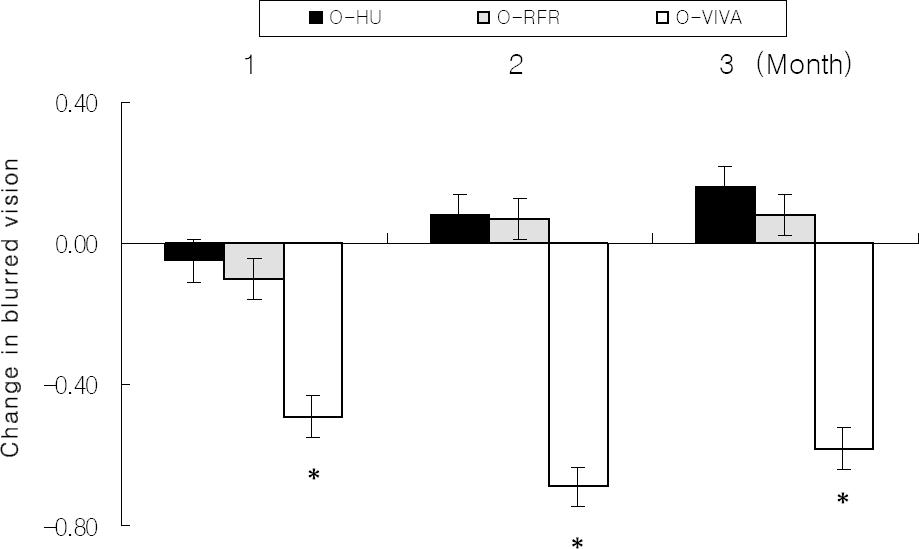
Figure 2
. Change from the baseline in tear breakup time. O-HU=Lacure®; O-RFR=Refresh plus®; O-viva Viva®; Mean value±standard error. The increase from the baseline in tear breakup time (sec) was statistically significant in group 3 at 2 months and 3 months. (* P<0.05 by paired-T-test).

Figure 3
. Change from baseline in Schirmer I test. O-HU: Lacure®; O-RFR: Refresh plus®; O-viva: Viva® Mean value± standard error. The increase from baseline in Schirmer test value (mm) was statistically significant in groups 3 at 3 months. (* P<0.05 by paired-T-test).
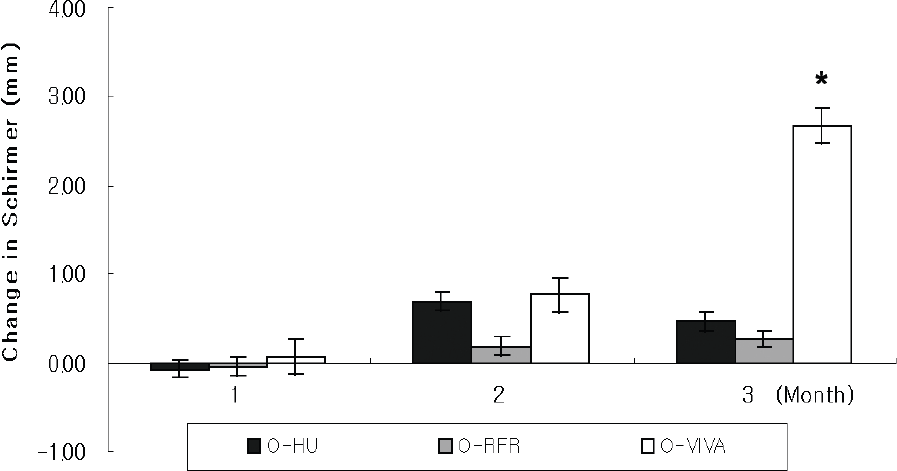
Figure 4
. Change from the baseline in impression cytology grade. O-HU=Lacure®; O-RFR=Refresh plus®; O-viva=Viva®; Mean value±standard error. The decrease from the baseline in impression cytology grade was statistically significant in group 3 at 2 months and 3 months. (* P<0.05 by Mann- Whitney U Test).
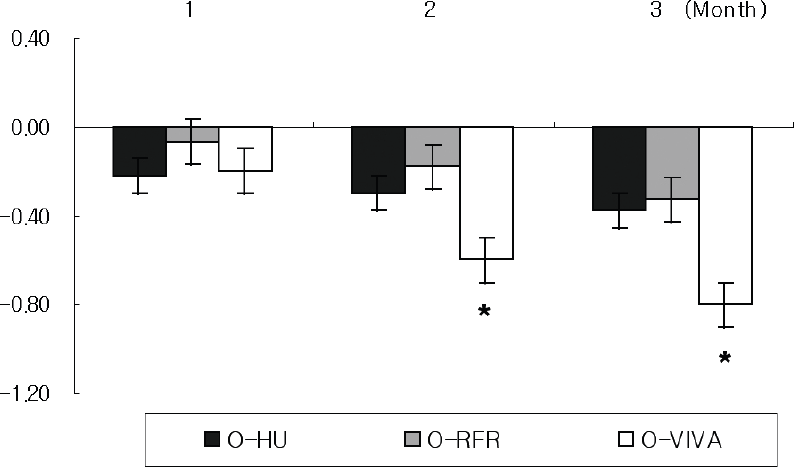
Figure 5
. Example of impression cytology after 3 months in each group. Group 1=Lacure®; Group 2=Refresh plus®. Group 3= Viva®. There was no significant improvement in impression cytology after 3 months in group 1 (A=Stage 3-initial; B=Stage 3-after 3 months) and group 2 (C=Stage 3-initial; D=Stage 3-after 3 months). But improvement of impression cytology was shown after 3 months in group 3 (E=Stage 3-initial, F=Stage 2-after 3 months) (×100, PAS-hematoxylin stain). <Stage 0- Normal, Stage 1-early loss of goblet cells, Stage 2- total loss of goblet cells, Stage 3- early keratinization, Stage 4- moderate keratinization, Stage 5- advanced keratinization>

Figure 6
. Change from baseline in goblet cells density. O-HU: Lacure®, O-RFR: Refresh plus®, O-viva: Viva®; Mean value±standard error. The increase from baseline in goblet cells density (cell/mm2) was statistically significant in group 3 at 2 months and 3 months. (* P<0.05 by paired-T-test).
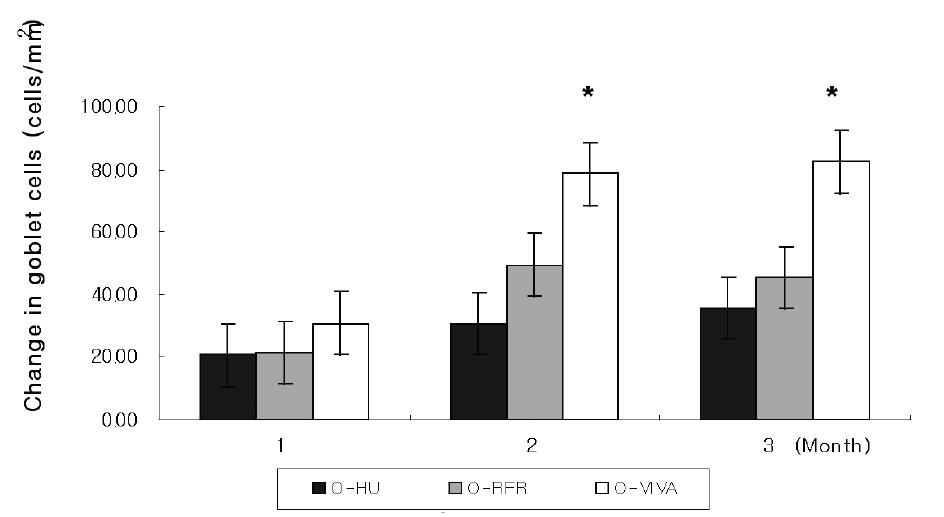
Figure 7
. Change from the baseline in corneal stain score. O-HU=Lacure®; O-RFR=Refresh plus®; O-viva=Viva®; Mean value±standard error. The decrease from baseline in corneal stain score was statistically significant in group 3 at 3 months. (* P<0.05 by Mann-Whitney U Test).
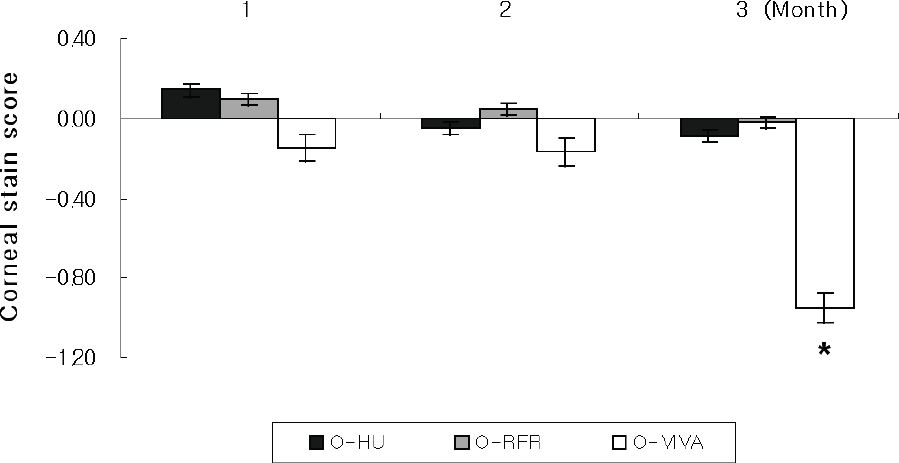
Table 1.
Initial characteristics of each group
Table 2.
Patient disposition during 3-month follow-up
| Group 1 | Group 2 | Group 3 | |
|---|---|---|---|
| Patients enrolled | 50 (100%) | 50 (100%) | 50 (100%) |
| Patients completed | 41 (82%) | 44 (88%) | 46 (92%) |
| Patients discontinued | 9 (18%) | 6 (12%) | 4 (8%) |
| Adverse events | 2 (4%) | 1 (2%) | 3 (6%) |
| Other reasons* | 7 (14%) | 5 (10%) | 1 (2%) |




 PDF
PDF ePub
ePub Citation
Citation Print
Print


 XML Download
XML Download